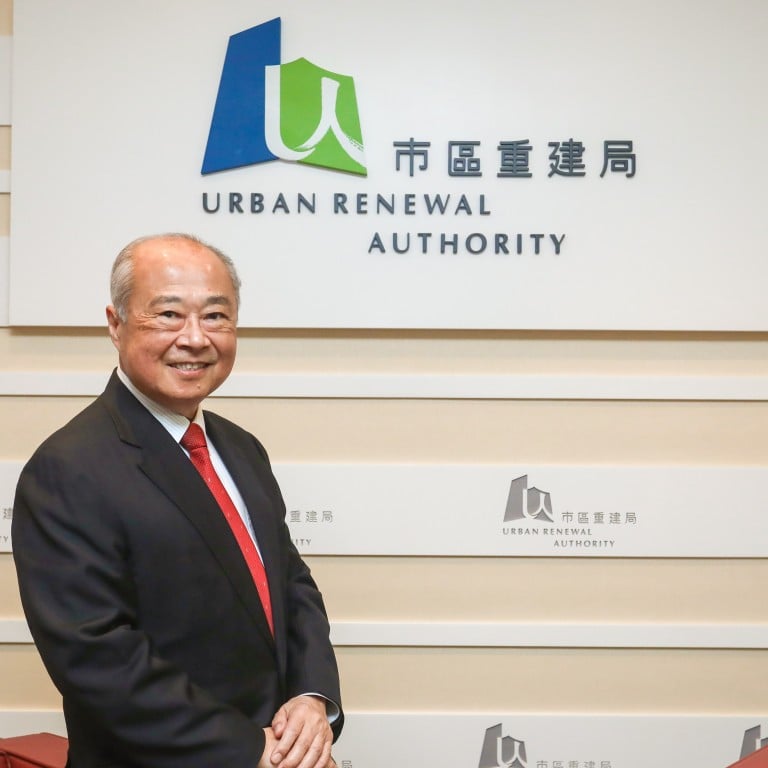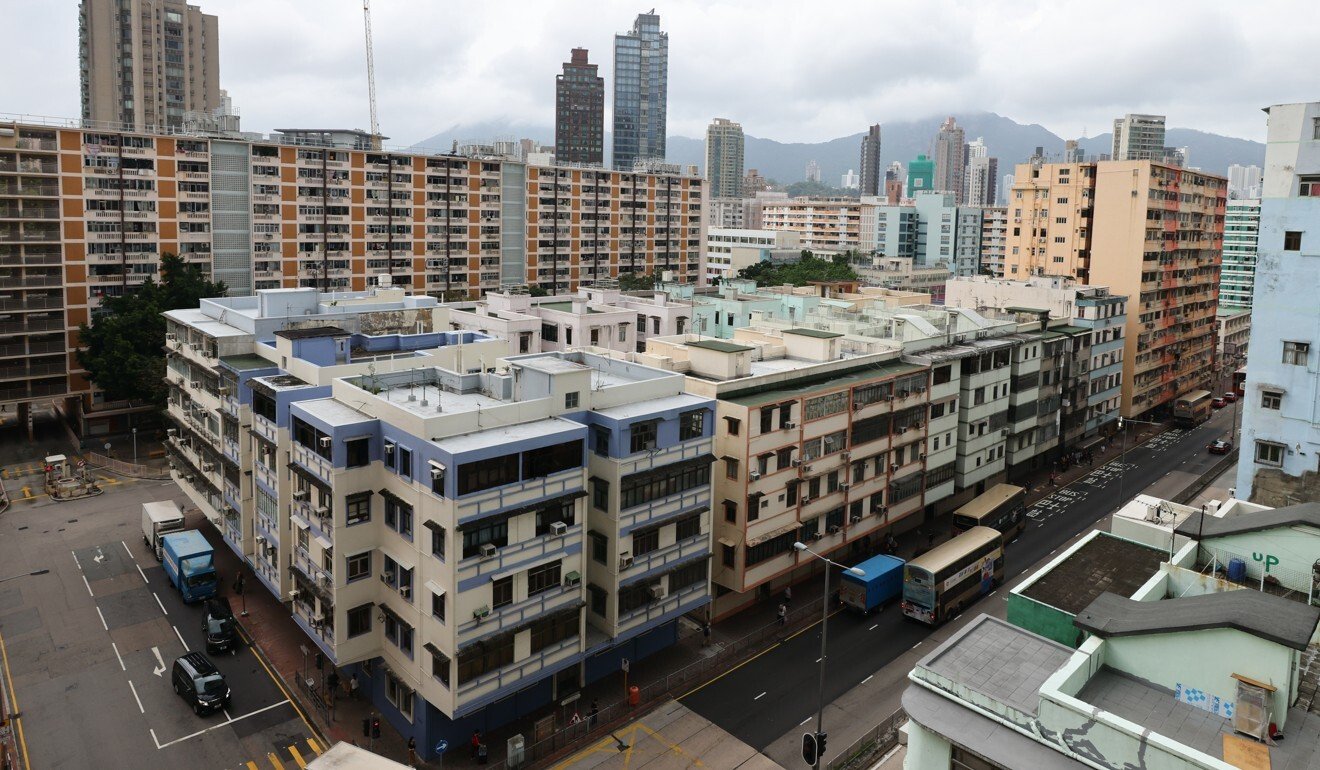
Hong Kong’s Urban Renewal Authority ready to build subsidised flats, but needs land to move faster, chairman says
- URA considering new approaches to meet target of building 18,000 flats in five years as Beijing pushes for elimination of subdivided homes
- Having enough land will help remove hurdle of ‘seven-year price’ for compensating owners
Hong Kong’s Urban Renewal Authority needs more land, not money, from the government to do a better job of boosting the city’s housing supply, according to chairman Chow Chung-kong.
Having the necessary land would free the statutory body to build homes and relocate residents without first having to pay hefty compensation to acquire buildings, he said in an interview with the Post.
The URA was also exploring new ideas for future projects, Chow said, including transferring plot ratios – which determine the built-up area on a site – between locations, enabling it to build more homes in prime spots and improve planning when redeveloping urban neighbourhoods.
Set up in 2001 to push urban renewal projects and promote building maintenance and conservation of heritage sites, the URA’s contribution to housing supply has dropped in recent years to just a few hundred new flats annually for the private sector.
But Beijing’s recent directive that Hong Kong eliminate tiny, undesirable subdivided flats in old buildings by 2049 has drawn attention to the role of the URA as a private housing provider.
“Our major purpose is to slow down urban decay. That’s how we look at our responsibility,” Chow said.
But he also stressed that the URA had committed to building 18,000 new homes in the next five years, including subsidised flats, making for an annual average much higher than over the past two decades, when it built 24,000 in total.
With its reserves and access to loans, he said, the authority was well placed to proceed with its HK$100 billion (US$12.9 billion) five-year plan, but land remained an issue.
“The first thing the government needs to resolve, and they are fully aware of it, is to create more land,” said Chow, who is a member of the Executive Council, the de facto cabinet of city leader Carrie Lam Cheng Yuet-ngor.

With enough land, the URA could build new flats and relocate residents from buildings earmarked for redevelopment, instead of continuing the current practice of paying existing homeowners to acquire their property.
Making that change would free the body from being hamstrung by a rule that requires it pay an amount equal to the average value of a seven-year-old flat for any residential property they acquire.
“That would be significant,” Chow said, noting the rule affected the URA’s cash flow and limited its ability to take on more projects simultaneously.
To recoup the acquisition cost, it then has to sell new flats on the redeveloped site at a higher price, often making them unaffordable even for middle-class Hongkongers.
At the height of the anti-government protests in 2019, Lam described the housing shortage as “a source of public grievances” and initiated a raft of measures, including giving the URA a new mission to build “starter homes” for first-time buyers and other types of subsidised housing.
Hong Kong has some of the highest property prices in the world, a chronic shortage of land for new developments and an average waiting time of 5.8 years for a public rental flat.
Chow said it would be much easier for the URA to meet the government’s targets for subsidised housing if it was provided land on which to build.
“If they want us to acquire a property at the ‘seven-year-old price’, demolish it … rebuild and sell below market price, we won’t be able to do it very often,” he said. “I cannot be doing that forever without being concerned about our cash flow and the speed of [other projects].”
Chow said the 56-year-old Tai Sang Sai Estate of low-cost rental flats in Shek Kip Mei showed the possibilities when the URA had land to build without acquisition costs.
It will redevelop the estate to build 3,300 flats, of which 2,000 will be starter homes while the rest will rehouse existing tenants. With HK$10 billion reserved for the project, Chow said the authority was considering getting a “nice place” – perhaps even renting a hotel – for them to live in during the transition.
Hong Kong leader defends efforts to ease housing woes at first town hall in 2 years
He also revealed that the URA was exploring new approaches for future projects to help it increase the supply of homes, including taking on bigger sites with multiple blocks, instead of working on one building at a time.
To save space within a neighbourhood being rebuilt, Chow said, government facilities such as fire stations and recreational areas like small playgrounds and badminton, could be stacked within a taller building instead of being spread out.
In areas with ample shopping centres, meanwhile, a new URA residential project could reserve all the buildable floor area for housing rather than adding extra shops.
Chow said the URA was also considering a new move to transfer plot ratios among sites in urban areas.
This could be done in core Kowloon commercial areas such as Yau Ma Tei and Mong Kok, for which the authority had already completed a redevelopment study and would be holding a public consultation this year.
Some sites could have a higher density of flats, with better architectural design ensuring the living environment was not compromised, Chow said.
Lawrence Poon Wing-cheung, a surveyor and former authority board member, said that in the Yau Mong area, for example, the plot ratio of a small, unprofitable site on an inner street could be transferred to a bigger site along the larger Nathan Road, or a site near a railway station.
That would allow the URA to build more homes and commercial units in more accessible spots, while the smaller sites could be turned into parks.
Poon said this approach would improve planning for the whole area, and private developers would also be keen to join in.
Chow also touched on the URA’s role in promoting building maintenance, aimed at prolonging the life of buildings from 50 to 70 years.
A challenge was that nearly a fifth of some 41,000 buildings in Hong Kong had no active owners’ corporations or management companies. Just over a fifth had such groups but they were no longer functioning.
Some of these buildings were in an unsatisfactory condition because there was nobody to take charge of maintenance or apply for various subsidies available, Chow explained.
The URA would explore the idea of organising owners of different buildings to jointly hire a company to take care of the whole area, which would help keep the cost reasonable, he said.
“Every time we do redevelopment, people say we are losing the community spirit … the only way we can preserve the community spirit is to maintain the buildings so they don’t have to be demolished or rebuilt,” he said.

